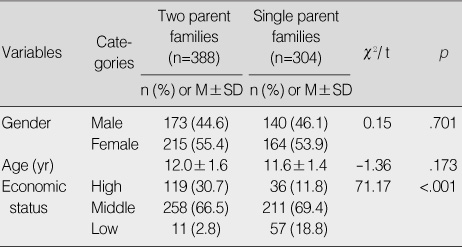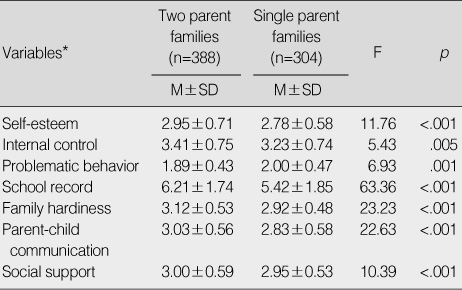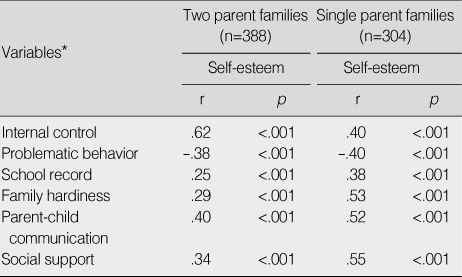Articles
- Page Path
- HOME > J Korean Acad Nurs > Volume 40(3); 2010 > Article
-
Original Article
- Comparison of the Factors Influencing Children's Self-esteem between Two Parent Families and Single Parent Families
- Sohyune R Sok, Sung Hee Shin
-
Journal of Korean Academy of Nursing 2010;40(3):367-377.
DOI: https://doi.org/10.4040/jkan.2010.40.3.367
Published online: June 30, 2010
1Assistant Professor, College of Nursing Science, Kyung Hee University, Seoul, Korea.
2Adjunct Professor, College of Nursing Science, Kyung Hee University, Seoul, Korea.
- Address reprint requests to: Shin, Sung Hee. College of Nursing Science, Kyung Hee University, 1 Hoegi-dong, Dongdaemun-gu, Seoul 130-701, Korea. Tel: 82-2-961-9144, Fax: 82-2-961-9398, sunghshin@khu.ac.kr
Copyright © 2010 Korean Society of Nursing Science
Abstract
-
Purpose
- This study was done to compare factors influencing children's self-esteem between two parent families and single parent families.
-
Methods
- The participants were 692 children aged 11 to 13 yr (388 in two parent families and 304 in single parent families) recruited from 20 community agencies and 5 elementary schools in Gyeonggi Province and Seoul City, South Korea. Data were collected from May to July, 2007 using a survey questionnaire containing items on self-esteem, internal control, problematic behavior, school record, family hardiness, parent-child communication and social support. The data were analyzed using SPSS 15.0 program and factors affecting children's self-esteem were analyzed by stepwise multiple regression.
-
Results
- Scores for the study variables were significantly different between the two groups. The factors influencing children's self-esteem were also different according to family type. For two parent families, internal control, problematic behavior, school record, and parent-child communication significantly predicted the level of self-esteem (adjusted R2=.505, p<.001). For single parent families, social support, family hardiness, internal control, problematic behavior, school record, and parent-child communication significantly predicted the level of self-esteem (adjusted R2=.444, p<.001).
-
Conclusion
- Nurse working with children should consider family type-specific factors influencing their self-esteem.
- 1. Achenbach TM, Edelbrock C. Manual for the child behavior checklist 4-18 and 1990 profile. 1991;Burlington, VT, University of Vermont.
- 2. Barens H, Olson DH. Parent-adolescent communication, family inventories. Family Social Science. 1982;University of Minnesota.
- 3. Cha YL. A study on the children's school adjustment. 2001;Seoul, Yonsei University. Unpublished master's thesis.
- 4. Cho KM, Joo HJ. A comparative study on the mental health, behaviors between the divorced family adolescents and parent family adolescents. Journal of Korean Academy of Psychiatric and Mental Health Nursing. 2003;12:543–551.
- 5. Cho SA. Differences in risk factors and protective factors according to the level of psychological maladjustment of children of divorce. 2004;Daegu, Keimyung University. Unpublished master's thesis.
- 6. Chung MJ, Yuh JI. Effects of individual and social factors on children's affective problems and self-worth. Korean Journal of Child Studies. 2009;30(3):71–82.
- 7. Dubow EF, Ulman DG. Assessing social support in elementary school children: The survey of children's social support. Journal of Clinical Child Psychology. 1989;1:52–64.
- 8. Han MH, Yoo AJ. The relation of stress and perceived social support to problem behavior. Korean Journal of Child Studies. 2003;17:173–188.
- 9. Han SS, Kim KM. Influencing factors on self-esteem in adolescents. Journal of Korean Academy of Nursing. 2006;36:37–44.ArticlePubMedPDF
- 10. Hwang MH, Yeo TC. Self-esteem and social-psychological adjustment of Korean children. The Journal of Child Education. 2006;15:165–185.
- 11. Jeon BJ. Self-esteem: A test of its measurability. Yonsei Nonchong. 1974;1:107–130.
- 12. Joo SH, Cho SW. Impact of conflict and nurturing factors for the divorced parents on the behavioral adaptation of their children. Korean Journal of Social Welfare. 2004;56:215–238.
- 13. Kim MJ. A study on factors affecting children's adaptation in single parent families. 2005;Seoul, The Catholic University of Korea. Unpublished master's thesis.
- 14. Kim MH, Kang MH. Relevant variables of children's self-esteem: Analysis of the causal model. Korean Journal of Child Studies. 1999;20:195–211.
- 15. Kim YR, An MJ. A comparative study on the difference of gender-role identity and self-esteem between children of broken homes and those of normal homes. Journal of Human Understanding and Counseling. 2005;36:105–124.
- 16. A report of population and households. Korea National Statistical Office. 2009;Retrieved January 20, 2010. from http://kosis.kr/metadata/main.jsp?c_id=1962004.
- 17. Kwon YM. The effects of parents' divorce on child self-esteem and socialization. 2000;Seoul, Chungang University. Unpublished master's thesis.
- 18. Lee KL. The effects of children's perceived communications with mothers, self-esteem on school adjustment. The Human Ecology Research Institute Dong-A University. 2003;11:197–214.
- 19. Lee YA. A study of perceived family adaptation in patient with chronic renal failure. Korean Journal of Nursing Query. 1995;4:147–164.
- 20. McCubbin MA, McCubbin HI, Thompson AI. McCubbin HI, Thompson AI, McCubbin MA. Family hardiness index (FHI). In: Family assessment: Resiliency, coping and adaptation-Inventory for research and practice. 1996;Madison, University of Wisconsin System. 239–305.
- 21. Min HY. The relation between juvenile deliquency and parent-adolescent communication, family cohesion and adaptability. Korean Journal of Child Studies. 1992;12:112–124.
- 22. Min HY. Loneliness of school age children: Relationship with locus of control and coping in the peer alienation situation. Korean Journal of Child Studies. 2002;23(3):51–63.
- 23. Min HY, Lee YJ, Kim KH. The relationship between mother-adolescent communication and adolescent's alienation in single mother-headed family and two parent family. Journal of Korean Home Management Association. 2008;26(3):15–23.
- 24. Nam HA, Yang S. Parenting stress and parenting role stress in parents of primary school student. Journal of Korean Academy of Psychiatric and Mental Health Nursing. 2005;14:323–334.
- 25. Oh KJ, Lee HL, Hong KY, Ha EH. K-CBCL: Korean children behavior checklist. 1997;Seoul, Chungangjucksung Publication.
- 26. Oh SH. A comparative study on family system and psycho-social characteristics among male-headed, female-headed, and normal families. Journal of the Korean Society of Child Welfare. 2001;12:77–107.
- 27. Park HS. The developmental mechanism of school resilience of Korean adolescents in poverty. Korean Journal of Youth Studies. 1998;5:147–165.
- 28. Park SH. A study of the relationship between parent-child communication style, family system and the child's self-esteem perceived by the child. 2004;Seoul, Yonsei University. Unpublished master's thesis.
- 29. Rosenberg M. Society and the adolescent self-image. 1965;Princeton, NJ, Princeton University Press.
- 30. Shin SH. A structural model for children's adaptation in divorced families. 2006;Seoul, Kyung Hee University. Unpublished doctoral dissertation.
- 31. Yoon HM, Ryu NM. Effects of family function, social support and self-esteem on elementary school children's problem behavior. Korean Journal of Social Welfare Studies. 2007;33:215–236.
REFERENCES
Figure & Data
REFERENCES
Citations

- Relationship between Tooth Brushing and Hand Washing by Family Type among Adolescents: A 2020 Nationally Representative Korean Survey
Eun-Jeong Kim, Gyeong-Won Ko, Eun-Ji Seong, Su-Jin Lee, Ye-Seo Lee, Chae-Rim Lee, Hye-Ju Lee
Hygiene.2024; 4(3): 317. CrossRef - The relationship between father absence and hostility among Chinese depressed youths: A serial mediation model and the role of self-esteem and frustration tolerance
Xiao-Ge Liu, Yang Li, Fang Xiong, Wen-Tian Li, Lian-Zhong Liu, Sullivan John S.
Frontiers in Pediatrics.2023;[Epub] CrossRef - Study on Factors Influencing Self-Esteem Among Children Based on Big Data Analysis
Ji Young Kim, Eun Hwa Jeong, Kangyi Lee
Korean Journal of Child Studies.2020; 41(6): 111. CrossRef - Changes in the Reciprocal Relationship Between Parenting and Self-Awareness During Adolescence: A Longitudinal Analysis of National Big Data
Il Tae Park, Won-Oak Oh, Anna Lee
Journal of Pediatric Nursing.2019; 47: e51. CrossRef - Case Study on the Mother and Daughter Myth from the Perspective of a Daughter in a Divorced Family: Implications for Counseling
Hee-Lan An, Yeon-Jin Kim
Korean Journal of family welfare.2018; 23(1): 37. CrossRef - Factors Influencing Adolescents’ Self-control According to Family Structure
In Young Cho, Ja Sook Kim, Ja Ok Kim
Journal of Child and Family Studies.2018; 27(11): 3520. CrossRef - The Effects of Gender Role Attitudes and Family Service Utilization on Self-Esteem among Single Parents
Sungeun Lee
Korean Journal of Human Ecology.2014; 23(1): 1. CrossRef - Health Knowledge, Health Promoting Behavior and Factors Influencing Health Promoting Behavior of North Korean Defectors in South Korea
Myoung-Ae Choe, Myungsun Yi, Jung-An Choi, Gisoo Shin
Journal of Korean Academy of Nursing.2012; 42(5): 622. CrossRef
General Characteristics and Homogeneity between Two Parent Families and Single Parent Families (N=692)
Differences in Level of Children's Self-esteem and Independent Variables between Two groups (N=692)
*Economic status was controlled as a covariance.
Correlation between Independent Variables and Self-esteem in Two Groups
*Economic status was controlled as a covariance.
Comparison of Factors Influencing Children' Self-esteem in Two Groups
*Economic status was controlled as a covariance.
*Economic status was controlled as a covariance.
*Economic status was controlled as a covariance.
*Economic status was controlled as a covariance.
 KSNS
KSNS
 E-SUBMISSION
E-SUBMISSION




 Cite
Cite

